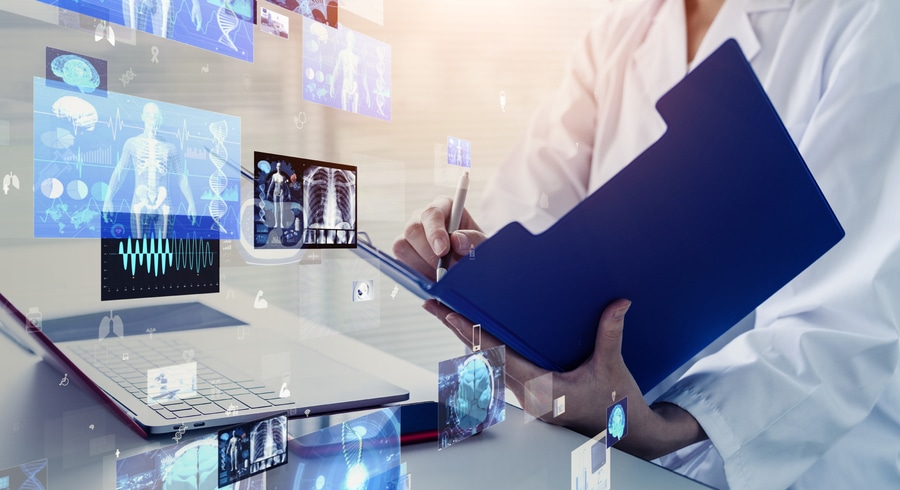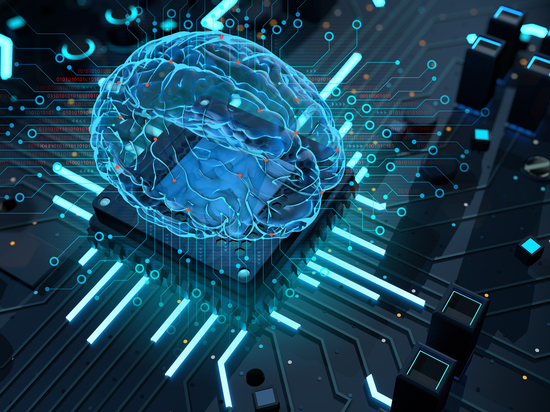
#Industry News
THE FUTURE OF HEALTHCARE: AUTOMATION FOR A BETTER TOMORROW
How machines could help and hinder the care of patients
In the not-so-distant past, booking a doctor's appointment meant dialing a phone and visiting an office in person. Today, it's a swipe and tap on your smartphone. Picture this: a 30-minute consultation, all without leaving the comfort of your home. Welcome to the realm of healthcare automation.
Today, we're shedding light on healthcare automation's diverse technologies and processes, including how to navigate their benefits and tackle challenges. Join us as we unveil potential solutions for integrating automation into your healthcare organization.
The Role of Automation in Healthcare
Automation is the use of technology to perform tasks that were previously done by people. In the healthcare sector, automation streamlines processes specific to this field, such as patient intake and medication distribution. With the advent of digital transformation, many of these processes, including EMR, telehealth, and remote patient monitoring, are now electronic or software-based.
Many medical groups, healthcare systems, and hospitals have switched to automated systems to:
Streamline administrative tasks. An automated system can handle vital but time-consuming tasks, like scheduling patients and sending appointment reminders. This frees medical staff to devote more time to patient care.
Enhance patient care and safety. Automated systems like patient monitoring can perform the same function continuously without suffering fatigue, loss of attention, or need for breaks. This helps minimize errors, vital in healthcare, as some can result in tragic consequences.
Optimize resource allocation. The large amounts of data handled by automation can be used for various purposes, from maximizing patient bed use to preventing employee burnout.
Advance medical research and diagnosis. Information like patient lab tests, heart rates, and oxygen levels can be sent to doctors in real-time. This helps make rapid treatment decisions, some of which can be life-or-death matters.
Benefits of Automation in Healthcare
In the expansive realm of healthcare, automation offers a range of benefits, catering to medical groups' overall goals and the specific objectives of individual departments. Let's dive into some of the most common advantages:
Improved Patient Outcomes
The medical community is constantly seeking ways to help patients get better faster. To accomplish this, automation is being used to:
Using 3-D printing technology, medications can be created specifically for patients, improving their effects on their condition while reducing risks and side effects.
Allow EMTs to use medical tablets to wirelessly transmit images of a patient's injuries while en route to the ER. This gives waiting medical staff more time to prepare, increasing the patient's chances of survival.
Enable providers to monitor their patients' medical conditions remotely via wearables. Staff can change drug dosages based on readings or react to emergencies like diabetic shock. This ability to monitor and respond in real time dramatically improves the likelihood of a full recovery.
Cost Reduction and Efficiency
The healthcare industry is known to be expensive, particularly in the US, where spending reached a staggering $4.3 trillion in 2021 alone. To reduce these expenses without compromising the quality of patient care, medical groups and physicians are increasingly turning to automation and other technological solutions.
Pharmacies automate their medical dispensing systems to allow the same number of staff to fill more prescriptions.
Dentists can create 3-D digital impressions of their patient's teeth through digital dentistry. This method is more accurate, less costly, and far faster than traditional methods using dental trays and putty.
Powered medical carts can alert hospital staff when they need to be restocked or vital medication has expired.
Minimized Human Error
Medical errors (or misdiagnoses) are heavily scrutinized, and with good reason. They are costly to cash-strapped hospitals and medical groups and can sometimes lead to fatal consequences. One study shows that medical errors cost groups $20 billion a year and resulted in 100,000 patients dying in the same period.
Automation in healthcare reduces errors by:
Patients directly fill out their intake forms via medical tablets or patient kiosks. This reduces or virtually eliminates the chance of errors made by the medical office staff on patients' personal information.
Virtual patient sitters with artificial intelligence (AI) can monitor high-risk patients in their rooms 24/7. If the patient does something dangerous, like getting out of bed without aid or pulling out their IV lines, the AI can alert medical staff to prevent further injury.
AI algorithms can flag electronic medical records (EMR) for dangerous drug interactions or suspicious behaviors like unusual drug requests or refills.
Better Data Management and Analytics
Modern medicine has access to a wealth of information, including patients' health records that can span over two decades to data on how poverty impacts fertility rates. However, it is impossible for healthcare professionals to sift through and make sense of this vast amount of data in a reasonable amount of time.
Automation has this capability. Artificial intelligence, in particular, has been trained to work with such large datasets. In healthcare, automated systems are being used to:
Assist radiologists in sorting a patient's X-ray or MRI scans (which can number in the thousands) for possible malignant tumors or other health conditions.
Help medical coders go through thousands of patient billings more efficiently as part of the revenue cycle management process.
Evaluate numerous applications to identify suitable candidates for testing drug companies' new formulas, speeding up the drug approval process.
In developing hospital menus, determine the food items patients prefer versus those they don't. This can help minimize food costs and waste.
Accessibility and Equity in Healthcare
Healthcare is not available equally to everyone. Medical clinics may be too far away for patients to visit regularly, or a hospital might not be adequately equipped to handle emergencies like newborns in distress.
Various technologies are being employed to address these differences in health services:
Patients living in rural or out-of-the-way places can get medical attention thanks to telemedicine, which connects them to their doctors through phone or two-way video conferencing. Patients with limited mobility, like many elderly, also benefit from this connectivity.
Thanks to remote patient monitoring systems like wearables, medical offices, and hospitals can monitor their patient's vital signs from a distance.
Predictive analytics can determine a patient's chances of being readmitted based on their living situation (for example, being economically disadvantaged).
Different Types of Automation in Healthcare
Automation doesn't apply to every aspect of healthcare. Patient relationships, like bedside care and surgical procedures requiring direct human interaction, are examples where automation is not applicable.
Other processes can, though. Many are repetitive and better handled by machines or similar devices and applications. Different forms of automation extend users' abilities to reach more patients or perform procedures more effectively.
Some of the processes that benefit from automation in healthcare include the following:
Electronic Health Records (EHR) and Medical Records Management
A patient's entire medical history was once stored in bulky paper files. Now EHR systems like Epic make it easier to keep, update, and view them by doctors and other authorized personnel.
Medical groups can also use programs to go through records to look for patterns like higher risk of cancer, drug abuse, etc.
Telemedicine and Remote Monitoring
To get medical care, patients typically visit their doctor at their office. Some cannot do so due to distance or lack of mobility (e.g., illness, use of public transport, etc.). Telemedicine, like two-way video conferencing, allows such visits without the patient leaving their residence.
Related technology also allows continuous patient condition updates through remote monitoring.
Robotic Surgery and Medical Procedures
Robotic or robot-assisted surgery equips surgeons with various robot arms, camera systems, robotic process automation (RPA), and surgical tools. These tools allow surgeons to perform certain surgeries with greater precision and control than standard—but more risky—techniques.
Artificial Intelligence (AI) and Machine Learning (ML) in Healthcare
In most sectors, AI and its ML subset process massive patient data. This is also true in healthcare. Examples range from detecting malignant tumors in a patient's MRI and CAT scans to creating new medicines based on a particular molecule. Patient satisfaction, which contributes to a hospital's finances, can be calculated using ML.
Pharmacy Automation and Medication Management
Numerous processes in the pharmaceutical sector have benefited from automation. For example, drug dosages can be precisely measured before they're packaged and sent to stores.
Medications can be closely tracked from the factory to the hospital to prevent theft and other misuse.
Challenges and Concerns
Automation has benefits for manufacturing and healthcare, but also poses challenges. Some, such as cost and worker displacement, are expected, while others are industry-specific, due to unique characteristics such as regulations and technological incompatibility.
Automation in the healthcare industry faces the following challenges:
Data Security and Privacy
Patient health information (PHI) in the US is highly regulated through the Health Insurance Portability and Accountability Act, or HIPAA. Due to its value to criminals, PHI is also subject to many cyberattacks.
Any automated system, such as an EMR, brought in to handle PHI should be secure. For example, a medical tablet with an RFID reader and Imprivata Single Sign On ensures that only authorized staff can use its EMR.
Workforce Adaptation
Many automated processes have been developed to replace work once performed by people. Transcriptionists, once familiar in medical offices, have been mainly replaced by EMRs.
Additionally, there has been talk for years of replacing radiologists and pathologists with computer-aided detection (CADe) and computer-aided diagnosis (CADx) systems.
To lower such reluctance, the advantages of automation to the group and how it'll help current workers should be emphasized.
Ethical and Regulatory Issues
As previously mentioned, healthcare automation generates massive amounts of data. Studies have already been conducted to develop new treatments based on information from patients' EMRs. While PHI is regulated legally, using that data to train AI skirts into patient privacy.
For example, should a patient's MRI scans be used in that training? Does the medical group need the patient's permission? Or is it no longer considered PHI if stripped of identifying features?
These and similar questions must be addressed as AI increasingly becomes part of the healthcare sector.
Technological Barriers and Costs
Many automated systems are costly. This can pose a severe challenge to cash-strapped hospitals and medical groups.
The new systems may also not be compatible with current medical equipment, which can increase the costs of upgrades. Finally, they may require staff retraining, which can take away time from patient care.
Medical-grade computers with legacy ports are a potential solution. They can bridge the divide between the varying automated systems and provide a familiar interface for staff to use the new features.
Explore the Benefits of Automation with Cybernet
Automation in healthcare aims to transform many practice standards in the sector. Medical groups are turning to digital tools and applications to lower costs, reduce errors, and reach more patients.
If you're eager to discover the advantages of automation for your medical clinic, hospital, or healthcare facility, contact the experts at Cybernet Manufacturing. We're here to guide you through the benefits of our medical-grade computers and tablets, optimizing routine processes such as maintaining patient EMRs. We can also assist you in navigating any potential challenges or drawbacks, including compliance with regulations like HIPAA.







